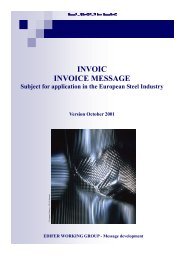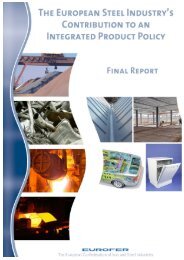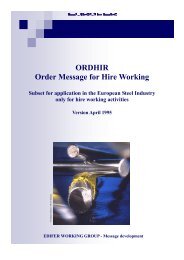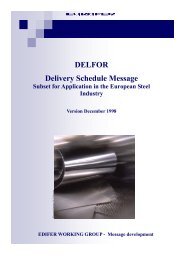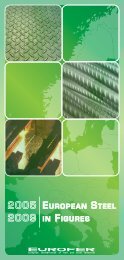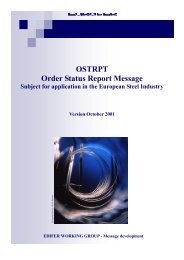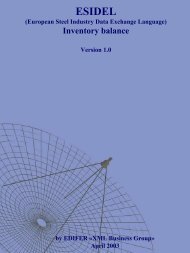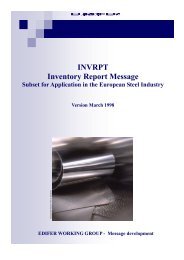manufacture, processing and use of stainless steel - International ...
manufacture, processing and use of stainless steel - International ...
manufacture, processing and use of stainless steel - International ...
You also want an ePaper? Increase the reach of your titles
YUMPU automatically turns print PDFs into web optimized ePapers that Google loves.
Information on the toxicokinetics <strong>of</strong> fume from the welding <strong>of</strong> <strong>stainless</strong> <strong>steel</strong> in<br />
humans comes from studies which have measured chromium levels in the blood or<br />
urine in mostly MMA/SS welders. The elevated urinary chromium levels reported,<br />
<strong>and</strong> in one study elevated RBC levels, provide evidence <strong>of</strong> chromium absorption as a<br />
result <strong>of</strong> exposure to welding fume. In some studies, the results indicated that<br />
repeated exposure may lead to accumulation <strong>of</strong> chromium.<br />
3.1.4 Toxicity<br />
Acute toxicity<br />
Animal data<br />
The effect <strong>of</strong> inhaled MIG/SS welding fume was studied in male rats following a<br />
single period <strong>of</strong> exposure (Hicks et al. 1983, 1984). The welding fume was generated<br />
using a mild <strong>steel</strong> workpiece <strong>and</strong> <strong>stainless</strong> <strong>steel</strong> electrode wire (Borstr<strong>and</strong> 61). Details<br />
<strong>of</strong> the chemical composition <strong>of</strong> the fume have previously been reported (see Section<br />
3.1.3). Twenty-four rats were exposed to fume (mean particle concentration 400<br />
mg/m 3 ) for 184 minutes; groups <strong>of</strong> six animals were killed <strong>and</strong> examined at 3, 24 <strong>and</strong><br />
48 hours <strong>and</strong> 7 days after exposure. In another treatment group, 30 rats were exposed<br />
to fume (mean particle concentration 580 mg/m 3 ) for 173 minutes; groups <strong>of</strong> six<br />
animals were examined at 12, 21, 28, 200 <strong>and</strong> 300 days after exposure. Unexposed<br />
animals served as controls. Results from the two exposure groups were combined.<br />
Early effects in the lungs consisted <strong>of</strong> inflammatory changes (pneumonitis <strong>and</strong><br />
bronchiolitis) which occurred 2-48 hours after exposure, followed by accumulation <strong>of</strong><br />
particle-laden macrophages throughout the lung <strong>and</strong> alveolar epithelial thickening (7-<br />
21 days). Particle clearance from the alveoli was incomplete 28 days after exposure;<br />
particle-laden cells were visible as peribronchial <strong>and</strong> subpleural aggregates, <strong>and</strong><br />
distributed throughout the lung. Foam cells, giant cells <strong>and</strong> marked epithelial<br />
thickening were also evident. These changes persisted 200-300 days after exposure.<br />
No collagen formation was observed at any time after exposure. This study showed<br />
that exposure by inhalation to MIG/SS welding fume at a particle concentration <strong>of</strong><br />
400 or 580 mg/m 3 for approximately three hours induced inflammatory changes in the<br />
lungs <strong>of</strong> rats.<br />
Inhalation toxicity <strong>of</strong> MMA/SS welding fume was investigated in rats following<br />
single exposure (Uemitsu et al. 1984). Welding fume was generated under laboratory<br />
conditions using SUS 304 <strong>stainless</strong> <strong>steel</strong> plate <strong>and</strong> a Lime-titania electrode. Eight<br />
male rats were exposed to welding fume by the nose-only for one hour. In the control<br />
group, eight animals were exposed to air only. The particulate content <strong>of</strong> the fume,<br />
which was monitored periodically during the exposure period, was 1088 13 ± 125<br />
mg/m 3 . Particle size distribution data were as follows: median diameter 0.56 µm;<br />
mass mean diameter 0.80 µm; aerodynamic diameter 1.51 µm. Chemical composition<br />
<strong>of</strong> the fume included the following oxides: 7.59% Cr (3.46% as soluble); 1.27% Ni<br />
(trace amounts as soluble). Animals were examined two, seven <strong>and</strong> fourteen days<br />
after exposure. During the 14-day post-treatment period, no deaths occurred in the<br />
13 The actual fume concentration was also reported to be 1008 ± 106 mg/ m 3<br />
53



